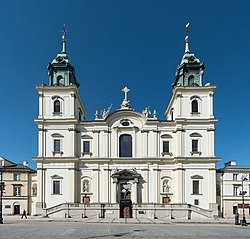Holy Cross Church, Warsaw
| Holy Cross Church Kościół św. Krzyża (in Polish) | |
|---|---|
 Church façade (center), 2021. | |
 | |
| General information | |
| Architectural style | Baroque |
| Town or city | Warsaw |
| Country | Poland |
| Construction started | 1682 |
| Completed | 1757 |
| Demolished | 1944 |
| Client | Michał Stefan Radziejowski |
| Design and construction | |
| Architect(s) | Józef Fontana |
Historic Monument of Poland | |
| Designated | 1994-09-08 |
| Part of | Warsaw – historic city center with the Royal Route and Wilanów |
| Reference no. | M.P. 1994 nr 50 poz. 423[1] |
The Church of the Holy Cross (
The Holy Cross Church is currently administered by the Missionary Friars of Vincent de Paul.
History
As early as the 15th century, a small wooden chapel of the Holy Cross had been erected here. In 1526 the chapel was demolished, and a newer church was erected. Refurbished and extended by Paweł Zembrzuski in 1615, the church was too small to fill the needs of the growing city.[2] Initially located well outside the city limits, by the 17th century it had become one of the main churches in the southern suburb (przedmieście) of the city that had in 1596 become Poland's capital.
In 1653 Queen

The main building was constructed between 1679 and 1696. Its main designer was Józef Szymon Bellotti, the royal architect at the Royal Court of Poland. It was financed by abbot Kazimierz Szczuka and the
From 1765 the church was one of the most attended by Polish King

During the Partitions, the church gained much importance, especially after the 1861 demonstration held before it, which was brutally put down by Russian Cossack troops — sparking the January 1863 Uprising.
On Christmas Day 1881, an outbreak of panic following a false alarm of fire in the crowded church caused the
In the late 19th century the church interior was slightly refurbished, and in 1882 an urn containing
Destruction and rebuilding

During the 1944
Between 1945 and 1953, the church was rebuilt in a simplified architectural form by B. Zborowski. The interior was reconstructed without the Baroque polychromes and frescos. The main altar was reconstructed between 1960 and 1972.
Traditionally, during the
Burials
Frédéric François Chopin (1810-1849): His heart is interred in the church. His body is buried in Père Lachaise Cemetery, Paris.
Trivia
- The Holy Cross Church and its gardens (now non-existent and occupied by the building of the Finance Ministry) gave their name to ŚwiętokrzyskaStreet, one of the most notable streets in central Warsaw.
- Following the signing of the Gdańsk Accords between
Images
Historical
-
1770s
-
Before 1828
-
1890s
Present day
-
The copper roof and bell towers of the church as seen from the west
-
Statue of Christ Christ Bearing His Cross, before the church
-
Plaque commemorating Bolesław Prus, "great writer and teacher of the nation, 1847–1912"
-
Plaque commemorating Polish general and prime minister Władysław Sikorski
-
Plaque commemorating Polish duchess, social and charity activist, Paulina Górska née Krasińska (1816-1893)
See also
- St. Casimir's Church
- Marceli Godlewski
- St. Florian's Cathedral
- Visitationist Church
External links
52°14′19″N 21°1′00″E / 52.23861°N 21.01667°E
Notes and references
- General:
- Franciszek Maksymilian Sobieszczański (November 1863). "Kościół Śto-krzyzki w Warszawie". Tygodnik Ilustrowany (in Polish). VIII (216). Archived from the original on 2015-09-23. Retrieved 2007-02-26.
- "kościół pw. św. Krzyża". Architektura Przedwojennej Warszawy (in Polish). Fundacja "WARSZAWA1939.pl". 2005. Retrieved 2007-02-26.
- ^ Zarządzenie Prezydenta Rzeczypospolitej Polskiej z dnia 8 września 1994 r. w sprawie uznania za pomnik historii., M.P. z 1994 r. Nr 50, poz. 423
- ^ a b c d e f g h i j k l "Historia". www.swkrzyz.pl (in Polish). Archived from the original on 2007-01-15. Retrieved 2010-02-20.
- ISBN 0-19-513146-0, p.162
- ^ "Requiem Mozarta dla Chopina w Bazylice Św. Krzyża" (in Polish). Retrieved 22 October 2021.
- ^ "Konkurs Chopinowski. Historyczne zmagania konkursowe członków jury" (in Polish). Retrieved 22 October 2021.








